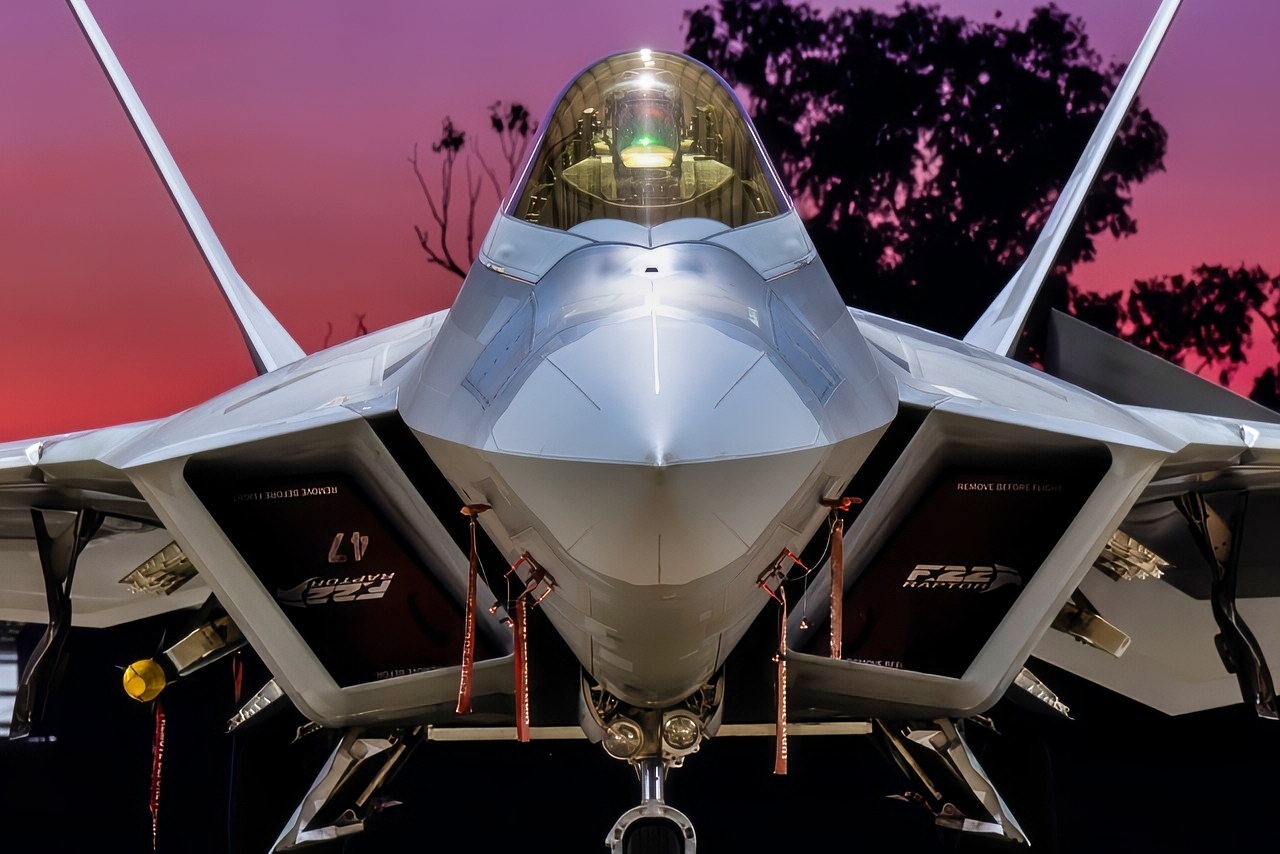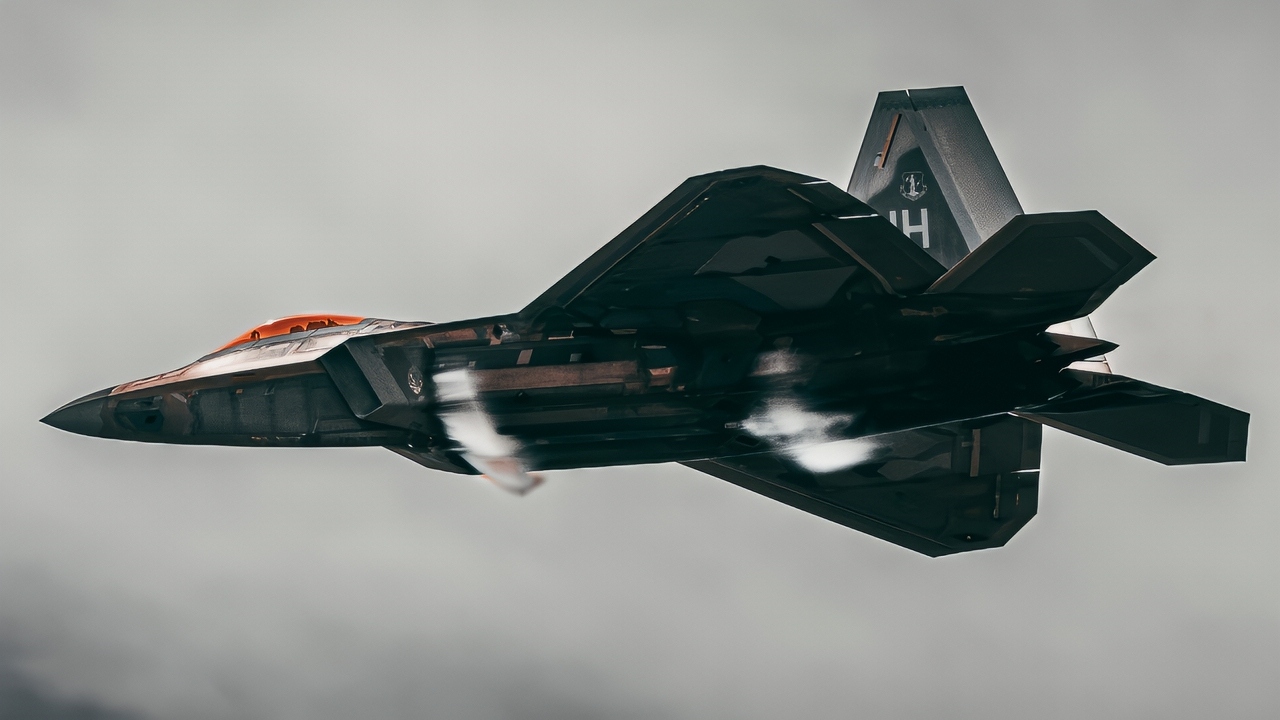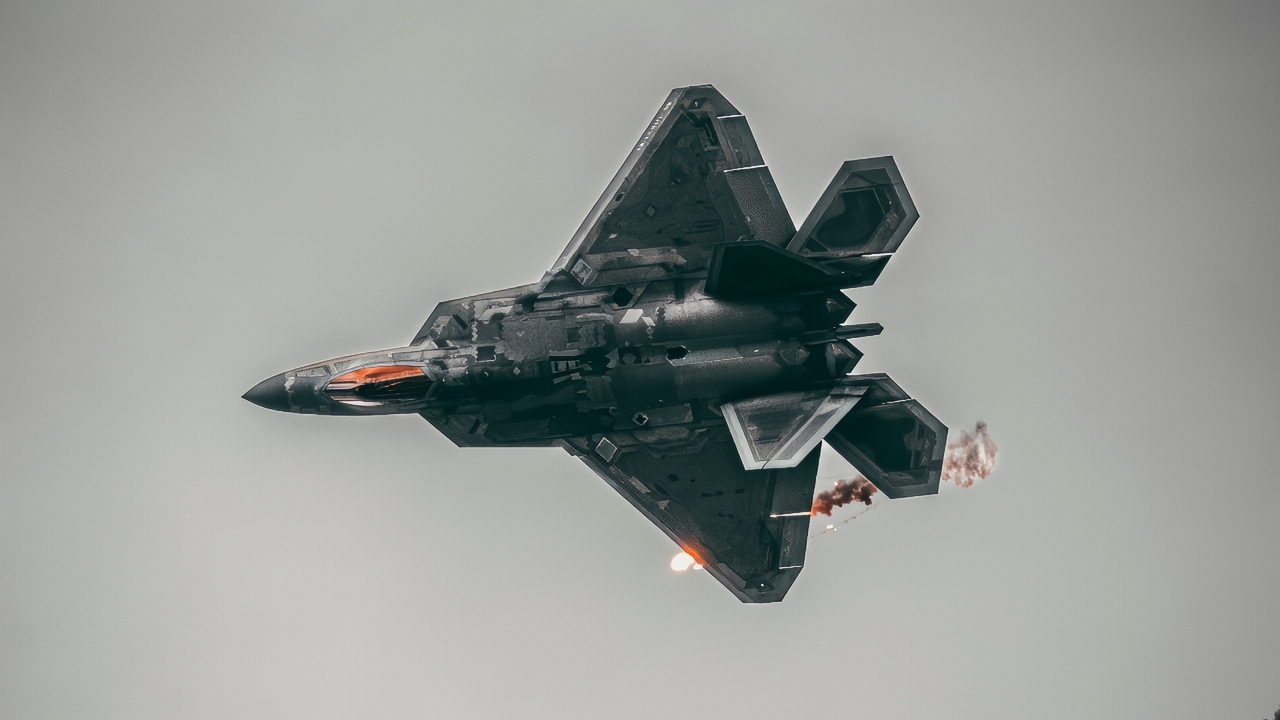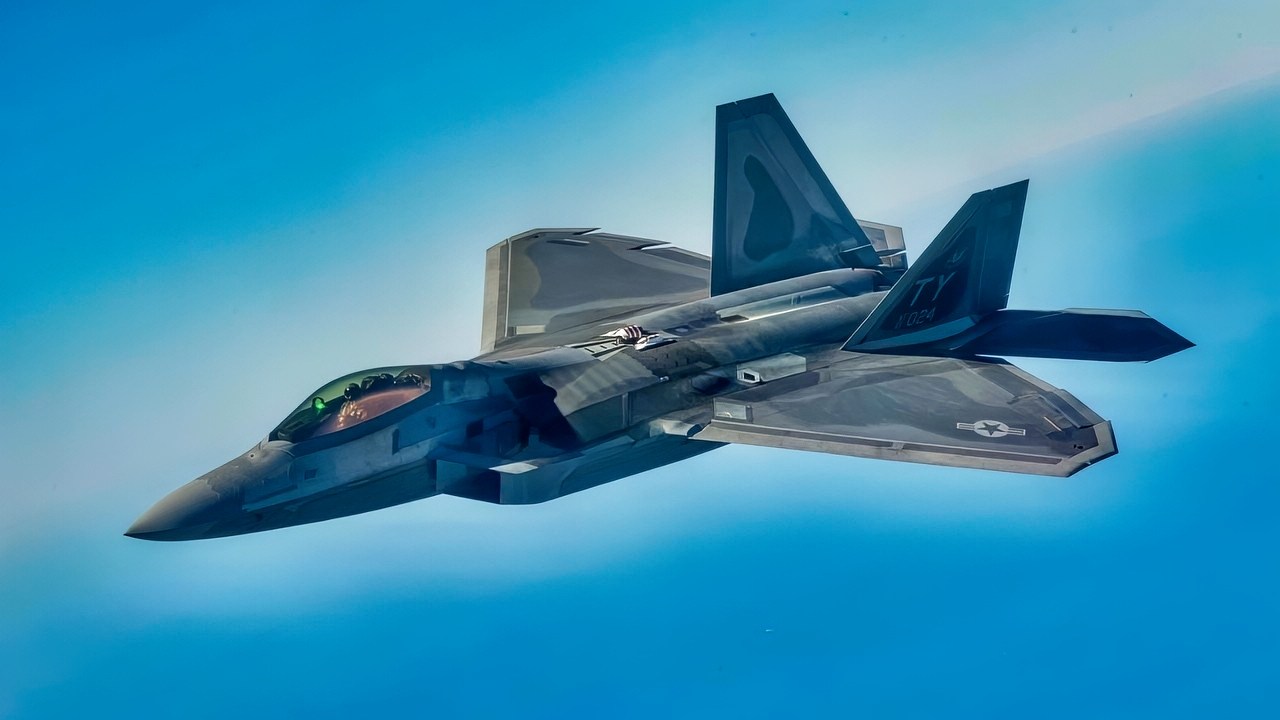Key Points and Summary – The U.S. Air Force is launching a major “viability” upgrade for its F-22 Raptor fleet to keep it dominant until the sixth-generation F-47 arrives.
-The modernization includes enhanced stealth, radar, electronic warfare, and a new infrared defensive system to counter advanced threats from China and Russia.

A U.S. Air Force F-22 Raptor assigned to the 199th Air Expeditionary Squadron sits beneath a hangar as the sun sets in Northern Territory, Australia, July 16, 2025, during Talisman Sabre 2025. Talisman Sabre is the largest bilateral military exercise between Australia and the United States advancing a free and open Indo-Pacific by strengthening relationships and interoperability among key allies and partners, while enhancing our collective capabilities to respond to a wide array of potential security concerns. (U.S. Air Force photo by Senior Airman Natalie Doan)

A U.S. Air Force F-22 Raptor performs a high speed pass during the 2025 Marine Corps Base Hawaii (MCBH) Kaneohe Bay Air Show, at MCBH, Aug. 9, 2025. The Kaneohe Bay Air Show provided an opportunity to showcase the aircraft, equipment, and capabilities of the armed forces in the Indo-Pacific region to the local community. The air show, which contained aerial performances, static displays, demonstrations, and vendors, was designed to celebrate MCBH’s longstanding relationship with the local community. (U.S. Army photo by Pfc. Peter Bannister)

A U.S. Air Force F-22 Raptor performs a vertical climb during the 2025 Marine Corps Base Hawaii (MCBH) Kaneohe Bay Air Show, at MCBH, Aug. 9, 2025. The Kaneohe Bay Air Show provided an opportunity to showcase the aircraft, equipment, and capabilities of the armed forces in the Indo-Pacific region to the local community. The air show, which contained aerial performances, static displays, demonstrations, and vendors, was designed to celebrate MCBH’s longstanding relationship with the local community. (U.S. Army photo by Pfc. Peter Bannister)
-This “bridging strategy” effectively buys time for Boeing, which is facing numerous challenges with its other aircraft programs and a major strike at its military production facilities.
-The investment in the F-22 ensures the U.S. maintains a top-tier air superiority fighter while the next generation matures.
Air Force F-22 Raptor Upgrade Program Buys Time for Boeing
The U.S. Air Force is moving ahead with a major modernization program for its F-22 Raptor fleet, aiming to keep America’s premier fifth-generation air-superiority fighter competitive well into the next decade.
In its budget request for Fiscal Year 2026, more than $90 million has been earmarked to launch a “viability” upgrade program that will bolster the jet’s stealth profile, radar performance, electronic warfare defenses, and overall survivability against rapidly advancing threats from China and Russia.
The F-22 Challenge Explained
While the F-22 remains a formidable and valuable asset, maintaining the fleet has become a costly exercise for the Air Force. Established maintenance procedures for the planes leave little margin for error in conflict scenarios, and the planned upgrades are designed to stretch the Raptor’s capabilities to their limit amid uncertainty about when Boeing’s F-47 sixth-generation fighter will enter operational service.
Central to the package is the Infrared Defensive System (IRDS), which will enhance the Raptor with advanced sensors capable of spotting long-range air-to-air and surface-to-air missile threats earlier and with greater precision. The proposed system draws on Lockheed Martin’s TacIRST technology, first integrated on contractor-operated F-5 Advanced Tiger jets.
Lots of Raptor Updates Planned
The program will run parallel to other F-22 enhancements already in the works, including an infrared search-and-track (IRST) system, housed in an external pod attached to the aircraft, for detecting low-observable aircraft, as well as stealth-optimized external fuel tanks designed to extend range without sacrificing speed or radar signature.

NGAD F-47 Fighter. Image Credit: Creative Commons.
Together, these projects form a critical bridging strategy, extending the Raptor’s lifespan and service utility until the arrival of the F-47, and providing a large fleet of upgraded fifth-generation aircraft that may still be used even after its successor enters operational service.
Does This Spell Trouble for Boeing’s F-47?
Even as the scope of the F-22 upgrade program broadens, Boeing’s sixth-generation F-47 program is still very much alive – and remains central to the Air Force’s long-term air-superiority plans.
But it’s hard to ignore the litany of problems Boeing currently faces.
Aside from ongoing controversies surrounding commercial passenger planes and the delayed Air Force One project, Boeing has suffered a number of recent embarrassments with newly delivered fighter jets.
Earlier this year, the U.S. Air Force grounded multiple new F-15EX Eagle II fighter jets due to a significant fuel venting malfunction that caused excessive and unpredictable fuel discharge. The technical failure undermines the F-15EX’s main selling point as a dependable, low-risk upgrade.

Shown is a graphical artist rendering of the Next Generation Air Dominance (NGAD) Platform. The rendering highlights the Air Force’s sixth generation fighter, the F-47. The NGAD Platform will bring lethal, next-generation technologies to ensure air superiority for the Joint Force in any conflict. (U.S. Air Force graphic)
Thousands of Boeing workers at three of its Midwest military aircraft manufacturing plants are currently on strike, too. On August 3, roughly 3,200 members of the International Association of Machinists and Aerospace Workers voted to reject a modified four-year agreement, sparking concerns that the aerospace giant could be forced to delay timelines for crucial U.S. military projects.
Despite this, the Pentagon remains confident that the F-47 program will deliver, requesting $3.5 billion in funding to develop the next-generation fighter while the U.S. Navy’s F/A-XX sixth-generation fighter program faces significant cutbacks.
The U.S. Air Force has confirmed plans to acquire more than 185 F-47s from Boeing – more than enough to replace all of the 143 combat-coded F-22 Raptors presently in service.
About the Author:
Jack Buckby is a British author, counter-extremism researcher, and journalist based in New York. Reporting on the U.K., Europe, and the U.S., he works to analyze and understand left-wing and right-wing radicalization, and reports on Western governments’ approaches to the pressing issues of today. His books and research papers explore these themes and propose pragmatic solutions to our increasingly polarized society. His latest book is The Truth Teller: RFK Jr. and the Case for a Post-Partisan Presidency.
More Military
‘Captain, We Have Been Hit’: A Tiny Nuclear Submarine ‘Sank’ $4.5 Billion Navy Aircraft Carrier
America’s F-35 Stealth Fighter Simply Summed Up In Just 1 Word
China’s New J-35 Stealth Fighter Simply Summed Up In Just 1 Word
The U.S. Navy Is Now ‘Cannibalizing’ Its Own Fighter Jets and Submarines
Operation Black Buck: How Avro Vulcan Bombers Broke Range Records in the Falklands War











Ryan M Beers
August 12, 2025 at 11:44 am
I honestly do want to see the f-22 in action and would HOPE BEG AND PRAY THE PILOTS CONTINUE TO STAY SAFE SINCE THAT’S THE BIGGEST CONCERN ABOUT PILOT SAFETY an afaik the f-22 was the pinnicle of the fighter aircraft on this planet..there forawhile at least which it is/was there for awhile
be-r.j.
August 13, 2025 at 1:03 pm
Oh, of course. Back when everyone was so eager to ditch the “ugly” Ethernet cables for the freedom of Wi-Fi. It’s just so funny how a few years of terrible security and lagging speeds made us all realize that a good, solid wire wasn’t such a bad idea after all. 😅😂🤣
JAIJAI
August 13, 2025 at 2:43 pm
I still remember the AF valuing these birds so much so that recently it was alluded that was the first 40 were built to a standard that the AF didn’t want. The feeling was wasting $$$ on planes they don’t ever want to use in combat was a ploy to move the program along to get the planes down the road that they wanted. Just think F22 damage from hurricane Michael. What was it $5 billion +? No one was fired. Apparently it was mostly planes from this first grouping. They still served a purpose to gain funding to repair upgrade(?). Remember that it was laid that every soldier/Marine serving in direct combat could be out fitted with best weapons, body armor etc. for less than half the cost of one these airplanes. Airforce went ballistic at the time. Yet now we know..,
Pingback: The B-21 Raider Stealth Bomber Is Already A Smash Hit - National Security Journal